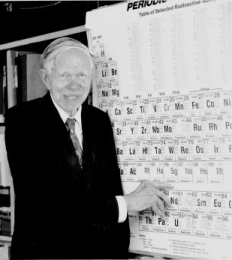 | But in 1996 a major change happened in the ‘direction’ of the Institute that was brought about by an American who is now shown on your screen. As a small boy he was brought up in a poor working class family where his grandfather had moved from Sweden as an immigrant worker. His father was a machinist like his own father before him and he said that he would most probably have become a machinist himself if it had not been for the family moving to California to find a better life. His name was Glenn Seaborg. Many of you here today will have never have heard of him, but fellow scientists around the world say that he was one of the 20th century’s greatest scientists. In this respect although he was a Nobel Laureate, he also attained immortality in the scientific world by having an Element on the Periodic Table named in his honour – Element106 Seaborgium. This greatest of all scientific accolades, higher than a Nobel Prize in the physical sciences, was also a unique situation for the world as well, for Glenn was the first person in the history of the world to be given this greatest scientific distinction whilst he was still alive. In this respect all other great scientists such as Einstein, Rutherford and Currie et al had this pre-eminent scientific honour bestowed upon them posthumously. The main reason for this was that he had discovered during his lifetime nearly 10% of all the known Elements in the Universe. |
Having been the scientific adviser to no less than ten Presidents of the United States from Roosevelt to Clinton, Glenn had witnessed at first hand on many occasions that decisions were being made that as a humanitarian he did not agree with. The dropping of the first Atomic Bombs on the people of Hiroshima and Nagasaki for one, and where he had implored the President and the military to use the ‘bomb’ only as an example and deterrent on unoccupied Japanese territory. His feelings were so strong, even though Glenn had been a major player in the development of the ‘bomb’ as Head of the Plutonium Plant on the ‘Manhattan Project’.
If there are any doubts in the minds of people here today who think that the ‘bomb’ should not have been built in the early to mid part of the 1940s, recent documents that have been discovered revealed that the Nazis were a lot closer to building the ‘bomb’ than had ever previously been imagined, and where they would have certainly have used the ‘bomb’ on the free-world killing literally millions of innocent people in the process. This if it had happened would have made it totally impossible for the liberation of Europe by the Allied forces. Indeed, these same documents tell us that at the end of WW2 the Nazis were trying to convert their V2 rockets so that they could carry the first nuclear weapons. This is not hearsay and is now documented and where those who were basically behind the building of the ‘bomb’ Einstein et al, knew full well that their fellow German scientists could quit easily come up with the same outcomes as themselves. The reason why Einstein wrote that now world famous letter to President Roosevelt, warning him of this very fact and which now according to history, nearly came terribly so close to reality.
Glenn also created most of the isotopes that are used in the treatment of Cancer through the application of the chemistry of Chemotherapy and which save literally millions of lives each and every year.
Unfortunately Glenn Theodore Seaborg passed away in 1999, but where we still feel that he is still watching over us and guiding our work.
Anyone who is interested to learn more about Glenn and his fascinating life only have to put the name Glenn T. Seaborg into google using inverted commas and where there is around 21,000 exact web hits.